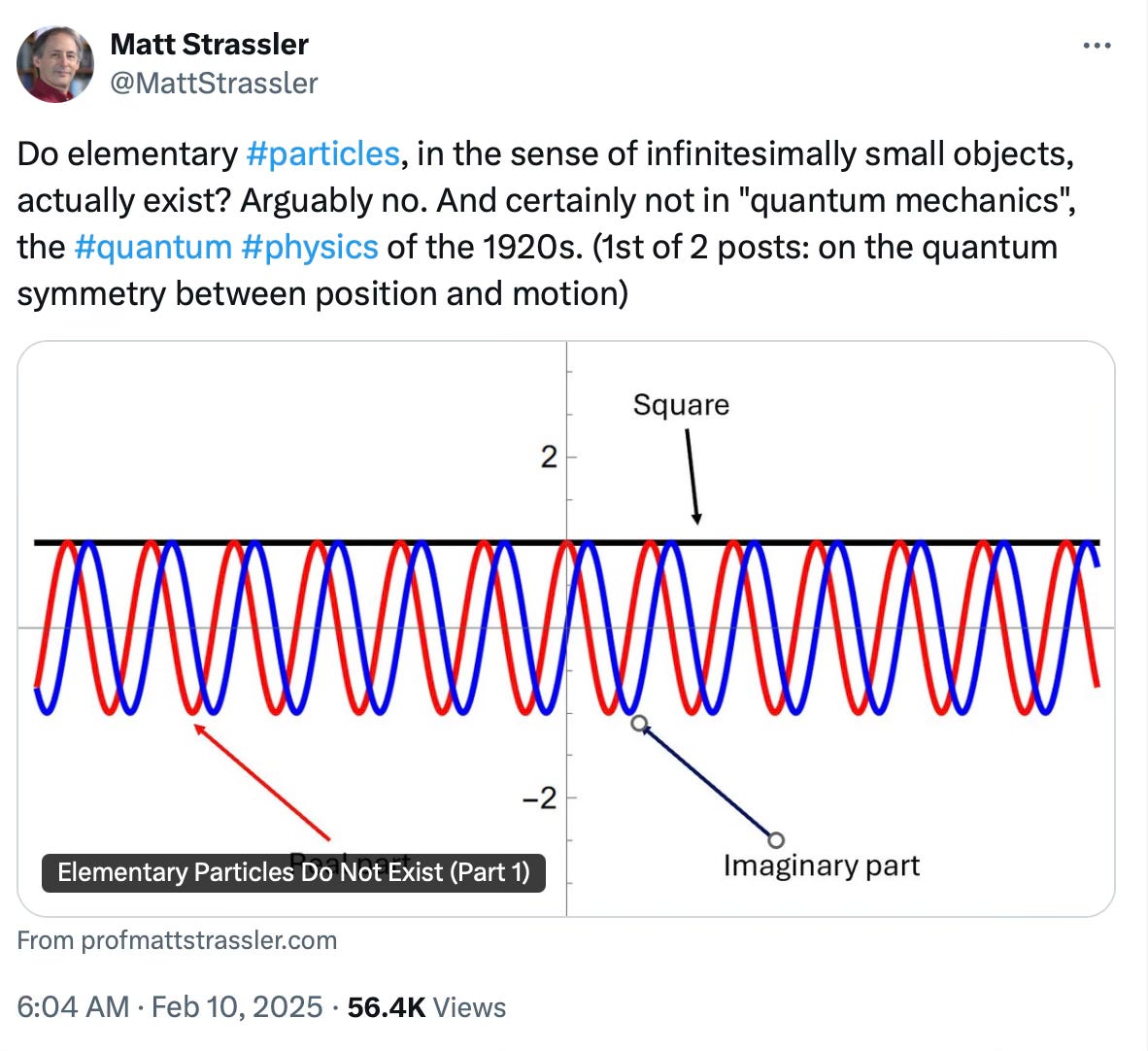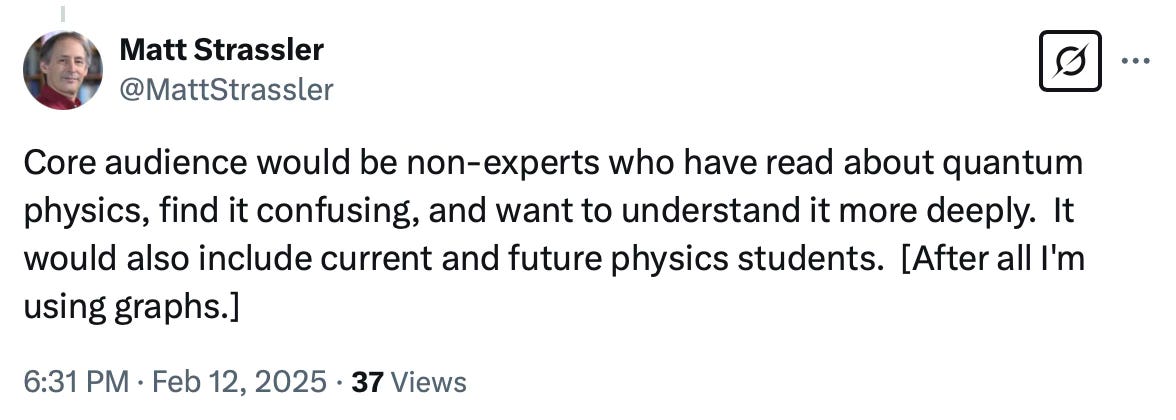On Talking Physics with the Crowd...
... without taking yourself too seriously.
Hey Friends!
Over the past year I’ve paused publishing in Math and Science media. With our modern media environment so scattered, I wanted to reconsider what effective communication looked like.
With this blog in particular, I was concerned that too much time was devoted to critical responses to other work. Aesthetically, I favor being constructive over being reactive.
My time away helped me refocus. Broadly, I’ve landed on a vision for what I’d like to write. Narrowly, I’ve agreed to go at least “one for one” with constructive versus critical pieces. After all, critical review certainly has its place in public discourse.
In any case. I’m writing again, and I’ve got a lot to say. Thank you for joining me and thank you for reading! Today’s piece is a twist on the notion of a critical repsonse. It’s a piece about nuance and scope. I hope you enjoy it.
Sean
Science vs Interpretation
There is a pattern of argumentation that comes perilously close to polemic disinformation1. That kind of argument goes something like this:
“You know that one thing that is intuitive and everyone seems to agree with and understand? Guess what? It’s wrong.”
When accompanied by new information, like a fresh experimental result, it can be exhilarating! If not, it’s just rhetoric. Rhetorically, this kind of argument advocates for a different interpretation of facts that are not in dispute. I worry these kinds of arguments confuse the general public.
Why?
In my own experience, individuals or students who haven’t actively engaged with ideas - those new to Physics, for example - take in arguments linearly, like data. The repeat them at face value. Even those prone to skepticism will approach me with simple True or False questions. For example, did we find the Higgs or didn’t we?2
This is totally normal. It takes everyone a while to wrestle with ideas long enough to synthesize a point of view.
If your aim is to communicate or advocate for Science, it’s hard to see how such iconoclastic arguments help.
But their use in teaching is another matter.
Do Particles Exist?
A few weeks ago Matt Strassler wrote a pair of pieces arguing that elementary particles don’t exist. He advertised the first of these on Twitter

If you've studied Quantum Mechanics, you might be familiar with the wave-particle duality enjoyed by matter3. This 20th Century discussion is the main theme throughout Matt’s pieces.
Despite this duality nuance, we know that particles exist. We know that some are fundamental4. In many cases we can observe them individually5. We talk about the Standard Model of Particle Physics all the time. So why bring this baroque, wave-particle identity up now?
My understanding of Matt’s argument was that the transition from Classical to Quantum Mechanics brings nuance that changes our perspective on matter. Similarly, the transition from Quantum Mechanics to Quantum Field Theory brings its own nuance. Ideas from Quantum Mechanics cannot be translated naively into analogs in Quantum Field Theory. The “particle” concept was one of those ideas.
To be clear, this is both fair and sensible. The whole point of studying quantum fields is that fields both elucidate otherwise ad-hoc phenomena ascribed to particles as well as organize their interactions6.
But we do have a common notion of particle in Quantum Field Theory. It is a little nuanced, but we use them specifically7 when computing interaction cross sections. The linearity of the Hilbert space of quantum states affords us some flexibility in doing the computations, and the usual statistical analysis of error allows us to quantify our knowledge and ignorance.
Yes particles are now to be perceived as excitations of quantum fields, but it remains true that in experiment, we throw two particles at each other and see what happens.
Particles - or whatever you want to call them - exist and remain the objects of study. Matt is advocating for a semantic change.
“I hope you can now start to see why I don’t find the word particle helpful in describing a QFT Bohron8. The Bohron does have some limited particle-like qualities, most notably its indivisibility, and we’ll explore those soon. But you might already understand why I prefer wavicle.”
Matt Strassler, The Particle and the “Particle” (Part 2)
In Physics - where truth is determined via negativa - do semantics matter? Is this a helpful perspective? Is it worth standing up to centuries of discussion and intuition about matter to pronounce the word “particle” in QFT language as “wavicle”? Or is there some kind of meaningful distinction between the two ideas at the boundaries of mechanics, quantum mechanics and quantum field theory?
I suppose it depends on who you’re talking to.
Teaching Physics
There is a parable often repeated in the study of Zen Buddhism, which occasionally attributed to Dōgen or Ch'ing-yüan Wei-hsin, that summarizes the learning process well.
“Before I had studied Zen for thirty years, I saw mountains as mountains, and waters as waters. When I arrived at a more intimate knowledge, I came to the point where I saw that mountains are not mountains, and waters are not waters. But now that I have got its very substance I am at rest. For it's just that I see mountains once again as mountains, and waters once again as waters.”
The same can almost certainly be said of Quantum Mechanics.
The idea of a particle is sensible to folks before and after coming to grips with the details of Quantum Theory. It is the process of learning itself which confuses us. While learning we absorb the nuance of how particles differ from “that which has no extent but includes a mass9”.
Matt’s idea of a wavicle serves to teach students who are on the path - those learning about Quantum Mechanics. It is very clear from reading his posts that clear pedagogy is important to him. Indeed, when asked about his audience for these pieces,
Given that the traditional ideas of Quantum Mechanics are often completely glossed over in the study of Quantum Field Theory, Matt’s pieces add an interesting framing to the discussion. Notably, his instance that the quantum field and the wavefunction of a physical state should not be confused is a great fact to stress to students early on the path10.
My biggest concern
Our media ecosystem is large, complicated and highly nonlinear. Outside of advertisements, you don’t often get to pick your audience. Algorithms do. Matt’s insistence on the wavicle framing of elementary particles ties directly to my biggest fear in Science writing, both technical and general. This was the core conflict that caused me to stop most my own writing for the better part of a year11.
How can I write material for one audience so as to not confuse others who might stumble upon it? Can I publish something for people on the path that does not confuse people who aren’t yet?
I now believe that answer is yes.
Signposting
This was the big insight that has slowly wormed its way into my feeble brain over the past year. Yes you can communicate complex, conflicting ideas with integrity so long as you signpost the context.
For example. What if Matt’s original Tweet started with something like this?
“We all know that elementary particles exist. But the mathematical representation of a particle is nuanced. And the lack of nuance in the conversation bugs me. Here’s why.”
You cannot think of every counterexample and weird take that any individual might have, but you can prevent the headlines from getting out of hand. You don’t even have to be formal or rigid about it, just acknowledge the context. This is not dissimilar from citing sources, and often the informal, preprint “pre peer review” process yields countless emails clamoring for additional context to be included in your draft.
By acknowledging consilience while diving into the nuance, we can make our argument clear to as many people as possible. Of course, this is also the intellectually difficult part, especially if you feel strongly about something. Without signposting context, you risk suggesting that there is a conflict or disagreement on Scientific fact where there is none12.
Communicating in our Media Environment
In teaching or communicating Science, there is a burden on the author: take your work seriously, but not too seriously.
For arguments of the type discussed today, this distinction hinges on Scientific falsification. Is this disruptive interpretation you are advocating for meaningfully different13 from the conventional viewpoint? If not, signpost. Just confirm to the low-involvement reader that you’re not saying something explosive.
Otherwise you’re putting your interpretation of the same facts above the equally valid interpretation used by almost everyone else. That’s a reasonable definition of taking your viewpoint too seriously.
Some authors routinely cross this line. Here is my response to one of Sabine’s more extreme examples:
Ben is a philosophically minded ML/statistics guy who was intentionally writing a polemic piece, purportedly in the style of Mach in the face of early 20th century statistical physics. His blog is worth checking out if you’re into those kinds of computational problems, but this piece was absolutely ridiculous.
If not, go read Matt’s blog!
That is to say, we know to the best of our knowledge that some particles cannot be represented as a bound state of other, “smaller” particles. The electron is a great example.
Disregarding of course Ben’s earlier point about Machian positivist empirio-criticism of actual observations. Muons, for example can be observed “directly” at sea level, but these detections rely on them inducing a cascade of other particles.
The physics of identical particles and perturbation theory are just the beginning. QFT is a rich subject full of surprising consistency requirements, such the implications of anomaly cancellation.
As Matt describes in his piece, these are the plane-wave, free particle approximations used in the so-called interaction picture formulation of scattering theory. By linearity, we can wrap them into whatever wavepacket models of individual particles we choose, specifying the uncertainty on their specific momenta as needed.
That’s the name Strassler gives to an abstract example of a physical field representing a spinless, chargeless particle, a singlet scalar field, if you like.
You could try to argue that point particles don’t exist in classical mechanics either, since macroscopically they’re just models for extended objects. For otherwise how might the force of friction act upon such a body without extent? Extending this to electromagnetism brings about a fun way to explore resolving singularities in the classical electromagnetic field. It’s funny the things you’re exposed to that you aren’t aware of in the course of undergraduate study.
It’s important to remember that Quantum Field Theory emerged slowly, like any Scientific endeavor. There’s a lot of residual reference to “Second Quantization” in older textbooks and the literature, which makes mistakes like that referenced above easy to make.
Per the introduction, my personal version of this conflict is happily resolved.
That’s one example of ways to confuse an audience, and I worry about it specifically. Pew puts out studies on the relationship between Science and Society often, but this one from a decade ago is worth a look. A deeper analysis of the same data revealed that religious views do bias respondents perception of Scientific consensus, but as representatives of Science we shouldn’t aid in confusing matters any further than need be.
Meaning, can it produce testable hypotheses that would contribute to new Science or contradict currently held assumptions?





great read! the idea of signposting to your audience is brilliant especially as someone still on that path of learning. the sheer volume of click bait physics content out there is sad to see, and I wish more science communicators would steer their audience in the right direction (at the risk of losing online interaction).
I’m glad sabines’ sensationalism was brought up too, more people need to talk about it. She’s attracting a concerning crowd of people because of it.
Scientists have been worshiping an optical illusion for the past 100 years and basing an entire science around it. And now it has become a religion with its gods, priests, and devout followers that question nothing. The religion is relativity. Papers opposing this religion in physics journals and even physics preprint archives is not permitted, also talks on this topic at conferences are not permitted, and even discussions in physics discussion groups is not permitted. The proof are the experiments, backed by theory, by many researchers showing that the speed of light is not constant at all, and is in fact instantaneous in the near field of the source. If relativity is wrong then so is any other theory based on it such as general relativity, and even QED. This will change all of modern physics! An experiment just published in the EM Journal IRECAP shows an EM pulse propagating 1.5 meters in the near field with no observed propagation delay. It shows that the front speed, or the speed of information, or the speed of causal action is instantaneous in the near field of EM sources. The paper shows that the phenomena is predicted exactly by Maxwell's equations when the source terms that come from Gauss's law and Ampere's law are inserted in the wave equation. This was not done by Maxwell and is the reason why his constant speed C solution is wrong, as well as Einsteins relativity which used this incorrect solution. For more information see New Interpretation of Relativity by William Walker, and specifically see the papers supporting the research in the description of the video.